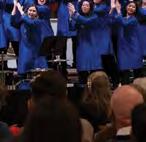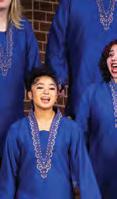
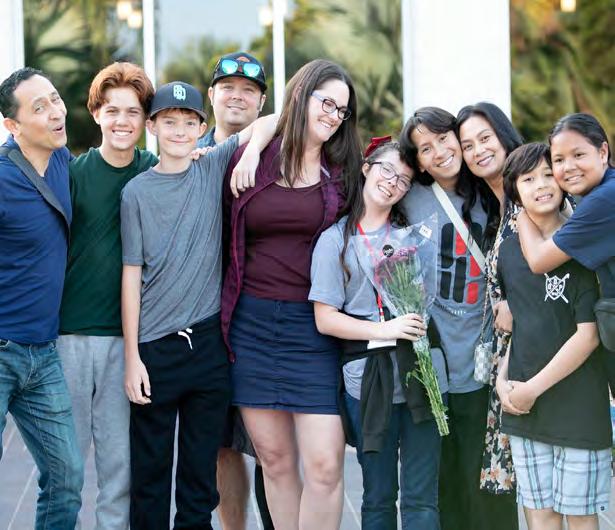
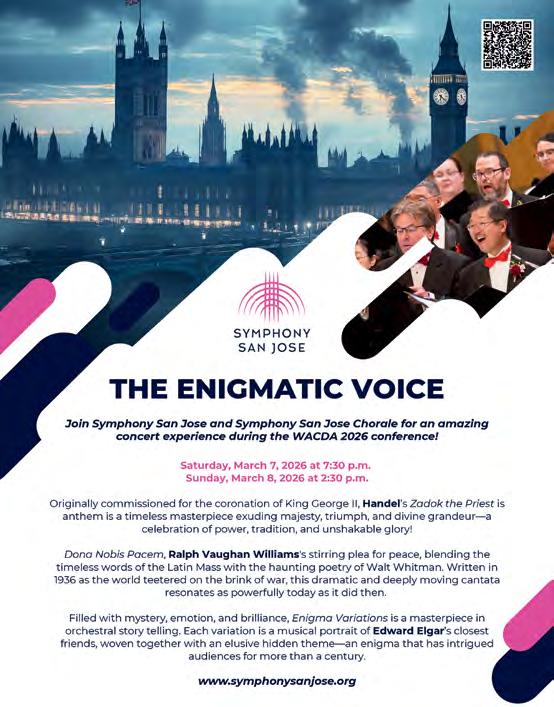




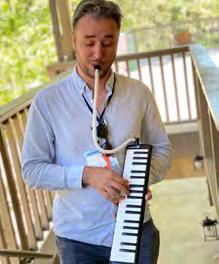
Official publication of the California Choral Directors Association, an Affiliate of the American Choral Directors Association
Eliza Rubenstein, editor cantate editor@gmail com
Ryan Yoder, content coordinator r yoder@bonita k12.ca us
We welcome and encourage CCDA members to contribute articles, announcements, music and book reviews, job vacancy listings, photos, and other items of interest to Cantate!
Please send queries and article ideas to the addresses above. You are also welcome to submit completed articles, but please note that not all articles received will be published.
Deadlines for publication are as follows: August 15 (Fall issue); November 1 (Winter issue); March 1 (Spring issue). The editor reserves the right to edit all submissions.
Please visit our website (www.calcda.org) or e-mail us at cantate.ads@gmail.com for complete information on advertising in Cantate, including rates, deadlines, and graphics specifications. Advertisements are subject to editorial approval.
On the cover: Participants in the Palomar Choral Academy celebrate with their families after their final concert at Palomar College in San Marcos.
WHEREAS, the human spirit is elevated to a broader understanding of itself through study and performance in the aesthetic arts, and
WHEREAS, serious cutbacks in funding and support have steadily eroded state institutions and their programs throughout our country,
BE IT RESOLVED that all citizens of the United States actively voice their affirmative and collective support for necessary funding at the local, state, and national levels of education and government, to ensure the survival of arts programs for this and future generations.
California Choral Directors Association empowers choral musicians to create transformative experiences for California’s diverse communities.
CCDAisa501(c)3 non-profit,tax-exempt corporation and an affiliate of the American Choral Directors Association.
Regional honoR choiRs novembeR 6-8, vaRious locations
casmec & choR al leadeRship academy JanuaRy 14-18, 2026, sacR amento
acda WesteRn Region confeRence maRch 4-7, 2026, san Jose


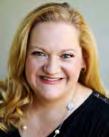
Kristina naKagawa is the executive artistic Director of vivace Youth chorus anD the artistic Director of resounDing achorD ProDuctions, both in san José. PreviouslY, Kristina DirecteD choirs at saratoga high school, st. francis ePiscoPal church, san José state universit Y, anD PinewooD school. as a soloist, Kristina has PerformeD in musicals anD cabaret shows throughout the baY area she receiveD a bm in vocal Performance from uc irvine anD a ma in choral conDucting from san José state universit Y. Kristina anD her husbanD, rYan, are the ProuD Parents of a vivace Youth chorus singer.
HelloCCDA! I’m new here…and also not. My journey as a volunteer with CCDA (known back then as California ACDA) began at the 2004 Coastal Region Honor Choir when I was a brand-new high school and middle school teacher. After teaching for 7 years, I changed my focus to community choirs where I currently experience the joy of conducting singers from ages 5 to 85. Since 2015, I have served on the CCDA Board and Advisory Council in multiple roles, and now I am honored to serve as your CCDA President.
I joined this profession because of the incredible privilege I’ve had singing for deeply inspiring choral artists. While I was a high school student in the California honor choirs, I sang for Perla Warren, who stretched my tonal comfort zone; Lynn Bielefelt, the first posthumously-awarded Howard Swan Award recipient; and Iris Levine, who I am now honored to call my friend. I was taught by Lois Carah, Joseph Huszti, and Charlene Archibeque— three very different people who challenged me while also giving me the encouragement and experience I needed to continue in my study. Because of them, I was free to believe and trust that the podium was a place where I could exist, belong, and thrive.
I am proud to lead an organization that is laying the groundwork for future conductors to exist, belong, and thrive, and giving all choral musicians, regardless of their age, gender, race, religion, or culture, the opportunity to experience the power of group singing. CCDA hit the ground running for the current program year with a wonderful Summer Conference at ECCO, where we enjoyed our time in the mountains with Andrea Ramsey and many other presenters. Here are some things Andrea said that I loved:
“Everyone has the right to use our literal and figurative voices in choirs.”
“Nobody ever got better at something and looked cool at the same time.”
“Creating is like playing with play-doh. You make something and if you like it, great! If you don’t, you just smoosh it and move on.”
Since July, CCDA has held local summer meet-ups and Northern and Southern Fall Conferences, and we are now preparing for the 2025 Central and Coastal Region Honor Choirs. There are lots of exciting events and programs for this year, and I hope you will take advantage of all that CCDA has to offer.
Part of my role as President is to recruit volunteers to serve on the CCDA Board of Directors and Advisory Council. We have filled one new position on the Board of Directors and one new position on the Advisory Council. Ryan Yoder from Bonita High School in LaVerne is serving as our Director of Communications to ensure that all our members and affiliates are informed about our events and activities. Let him know what you’re up to so that we can celebrate you! On the Advisory Council, Lori Marie Rios from College of the Canyons is serving as the Liaison to Past Leadership. One of my personal goals as President is to reconnect our organization with the leaders who have served CCDA in so many ways and learn all we can from them, and Lori Marie is a master at bringing people together.
Iwant to close with gratitude to the leaders whose are stepping away from positions on the Board of Directors and Advisory Council. Daniel Afonso, Jr., Kira Dixon, Buddy James, Kent Jue, Iris Levine, Albert Mabeza, Chris Peterson, and Zanaida Robles, thank you for your service to CCDA and to our profession. We deeply appreciate your care and dedication. Now, friends, go out there and smoosh some play-doh. I can’t wait to see what you create!

eliza rubenstein is the Director of choral
anD vocal activities at orange coast college, anD the artistic Director of the orange count Y women’s chorus she holDs Degrees from oberlin college anD uc irvine, anD she is a former animal shelter suPervisor anD the co-author of a booK about Dog aDoPtion eliza’s familY incluDes her Partner, Julie fischer, anD five Dogs. she’s Passionate about vegan thai fooD, PhotograPhY, anD the st louis carDinals anD st louis blues
This past spring, my students performed Mozart’s Requiem. It’s a work I’ve revisited countless times in the past few decades, as listener and singer and conductor, but the Mozart Requiem performance that looms largest in my life is one that took place four years before I was born.
On Monday, May 4, 1970, in the wake of President Richard Nixon’s escalation of the war in Vietnam and newly-announced incursion into Cambodia, college students across the nation were reacting with protests and sit-ins. That afternoon, at Ohio’s Kent State University, four unarmed students—two were protesters, two were bystanders—were killed by National Guardsmen who’d been called to the campus by the governor. Nine other students were shot and wounded, some gravely, as 28 Guardsmen fired 67 bullets into the crowd in 13 seconds.
Robert Fountain, who directed the Oberlin College Choir at the time, said after the fact that he had never mixed music and current events until that week; indeed, he considered himself apolitical.
But unprecedented times created unexpected activists. Over a thousand Oberlin students boarded buses for a seven-hour trip to Washington, D.C., and 250 of them brought their instruments or their choral attire.
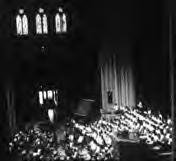
An hour to the west, at Oberlin College, where I would enroll 21 years later, students heard the news over the campus radio station and responded in grief and outrage. Classes were cancelled. Meetings were convened. And an extraordinary event began to take shape.
You might know about Oberlin’s long history of progressive rabblerousing, but most of it hasn’t come from the students in the school’s famous conservatory of music. Several “connies” at the time recalled later, sheepishly, that they were initially grateful that classes were cancelled so they could have more time to practice. The legendary choral conductor
On Saturday, May 9, they joined 100,000 peaceful protesters on the National Mall. That night, they held an open dress rehearsal of the Mozart Requiem at the National Cathedral. And the next night, after sleeping on the rectory floor, they performed the work— Robert Fountain wore a white armband as he conducted—for a packed sanctuary, many of them exhausted and barefoot, but all of them moved by the memorial for four fallen college students, countless fallen troops, and a society of fallen dreams.
To sing in the Oberlin College Choir, even decades later, was to know the story of the students who learned the Requiem in two days and huddled in bus seats overnight to bring its consolation and its gravitas to the nation’s capital. I am sure I’m not the only “Obie” who’s carried it with me as an example of how to make music matter, how to be uncomfortable in the service of great art, how to stand for integrity amid chaos.
Outrage can incite us to courage. Tragedy can radicalize us to beauty. What will be the moment for us? Where will our buses take us? What will we sing when we get there?
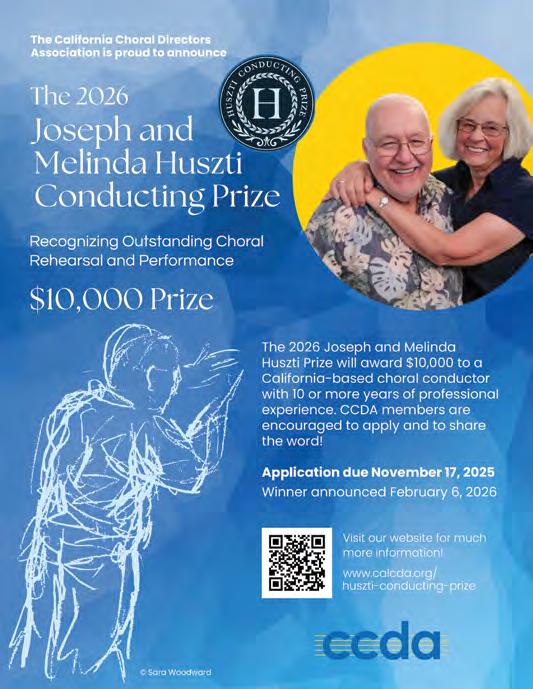
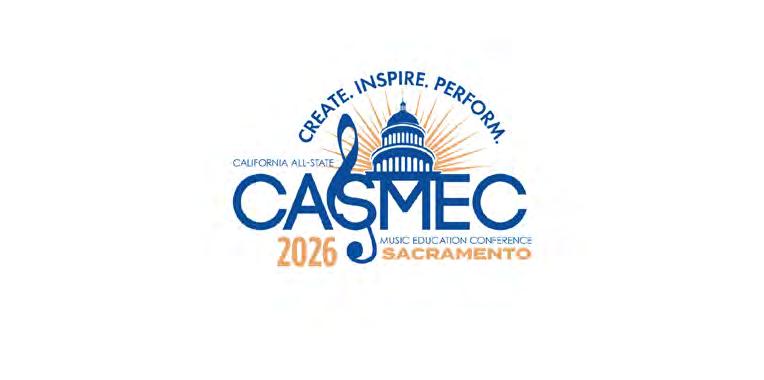
January 14th-18th Registration opens August 20th!

casmec.org

Guest Performing Choirs & I nterest Sessions!
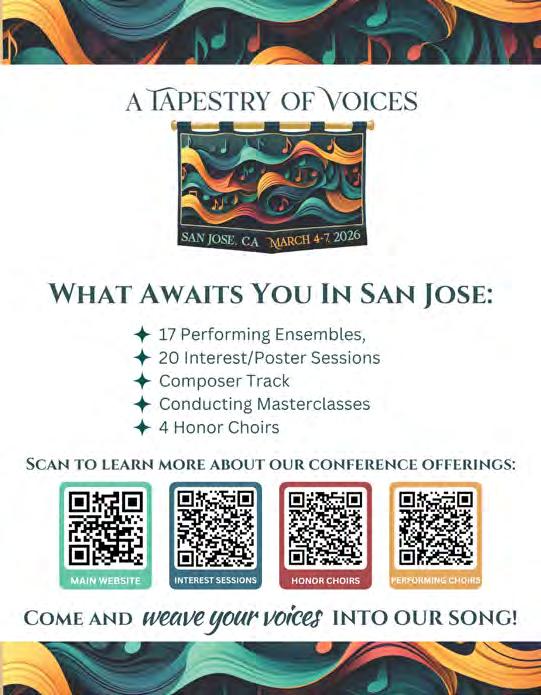
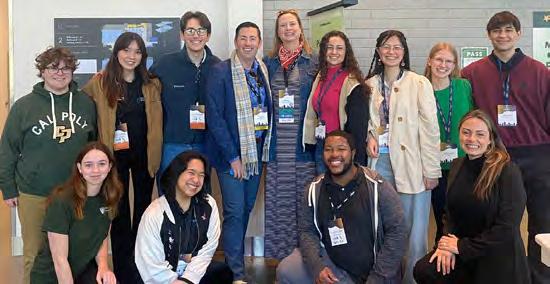
Researched and written by
Kaitlin Chheng (CSUF, President)
Willa Navarro (SJSU, President)
Hannah Park (CSUF, Past President)
Quintessa Wedell (CSUF, Treasurer)
Lindsey Lacanilao (CSUF, Secretary)
Supervised by Corie Brown (SJSU; CCDA Student Chapter Liaison)
Ihave recently had a similar conversation on repeat with college and university colleagues about ACDA student chapters in California. Simply put: the pandemic wiped out our burgeoning chapters and we want them back. Pre-pandemic, many of us were just starting to gain traction with the creation of new chapters. We had recruited student leaders and were mentoring them through the necessary bureaucratic processes. Others had small but mighty existing chapters. Fast forward to 2025 and we’re clear on the benefit of a student chapter both to our students and our programs, but possibly haven’t found the time or the critical mass of students to make it happen. The
value of an ACDA student chapter is clear, but it is a challenge to launch a new one. Enter: students. Our newest colleagues— student leaders in their respective chapters— volunteered to share with us their top tips to set up or revive an ACDA student chapter. It is the result of reflective zoom meetings, hard work, and informal conversations between Californian students and faculty about what makes a successful student chapter. We are beyond grateful to this enthusiastic group for putting together this guide and sharing their experience with the state and I urge you to share this with your student leaders as an excellent starting point. As it has inspired me, their work is sure to be the push you need to take the leap! Corie
Across the nation, ACDA Student Chapters continue to live out the mission to “inspire excellence in choral music through education, performance, composition, and advocacy” to the upcoming generation of music scholars. Student chapters provide unique learning opportunities outside the classroom and cultivate a collective space for students to share their zeal for choral music. In practice, many chapters form the organizational backbones of their respective music programs through structured volunteering, hosting student-run events, and raising travel funds for conference attendance. We have seen how our chapters encourage passionate drive and facilitate our transitions from students to teachers. It is our hope that student chapters ignite genuine connections within music, and we are excited to support the growth of student chapters throughout the state.
The process of starting a student chapter and keeping it alive is a daunting task. However, through our experiences as seasoned student leaders from California State University, Fullerton (CSUF) and San José State University (SJSU), we will guide you through some of the most important elements of this process.
Beginning a chapter is an exciting endeavor, and it needs student leaders who can spearhead the organizational elements along with the support of a faculty advisor. Since the American Choral Directors Association is a national organization, creating a collegiate chapter that abides by ACDA’s norms as well
as your institution’s norms involves a few additional processes. Along with these basics below, taking things step by step and asking for help will keep you on track.
Secure a faculty advisor. Typically, this role is filled by a choral director who is willing to advise and take an active part in supporting the student chapter.
Enroll in ACDA membership. The faculty advisor and the chapter president must be registered as ACDA members. Student memberships are $15.
Find motivated student leaders. Your institution will likely require three to five students to establish a club, with two serving as President and Treasurer. After filling these positions, the next suggested priority would be to instate a Secretary and Public Relations Chair as you establish your board. It is optimal to recruit students who are effective communicators and dedicated leaders ready to undertake this project.
Complete paperwork for your institution and ACDA. Submit a club registration to your campus’ Associated Student Body. The board and advisor will also need to submit an ACDA “Quick-Start” form, an ACDA “Registration” form, and write an email to National ACDA stating the club’s intent to be regarded as an official student chapter. These forms are linked on the official student manual, accessible through the ACDA website under the Student Resources page. In addition, at the end of the academic year, the board will need to write end-of-semester reports detailing membership numbers, chapter activities, and goals for the next year as testament to the club’s development.
Draft your organization’s constitution. The chapter will likely be required to devise a club constitution following their institution’s bylaws and the ACDA bylaws, noting that if these are at odds, the school bylaws take precedence.
Organize meeting structure. Given the connection to the national organization, many existing chapters organize their reports
and minutes according to “Robert’s Rules of Order.” This is a formal, professional method to call meetings to order, ensuring fairness and efficiency. The CSUF Student Chapter has found that using “Robert’s Rules” works well for both board and general meetings, while the SJSU Student Chapter prefers this method solely for board meetings.
Create a Chapter Vision. Before the first ACDA student meeting, it is recommended that the established board decide on their “Chapter Vision,” outlining their goals and the type of lasting impact they hope to have. When doing so, it is helpful to consider your institution, its music program, and the ensembles’ culture, tailoring the club to best fit the needs of your potential members. This may include diverse social events, professional development workshops, and volunteer opportunities to impact the surrounding community. Creating a personalized mission statement, a rough calendar of event topics, and a list of community outreach opportunities can help to solidify the vision.
Hold student board meetings. Throughout the year, it is helpful for ACDA student leaders to have regular board meetings to make decisions and discuss upcoming events. Having an open-door policy to board meetings demystifies the process and allows observing members to get a clear picture of the team’s inner workings and responsibilities.
Run quality meetings. One of the most impactful aspects of a thriving student chapter are well-run meetings. Meetings should strive to be consistent and memorable to encourage member attendance. This gives students something to look forward to and reinforces the chapter’s place in their schedule. For a new chapter, aiming for a few meetings each semester is a good place to start.
Host diverse events. For the first meeting of the semester, hosting a fun social event promotes high-energy engagement and sustained involvement for the rest of the year. Social events such as game nights, karaoke, and movie nights are simple to coordinate and provide low-pressure environments for potential new members. Bringing music faculty and community educators to present
on their areas of expertise is an effective method for professional development events. Through their mentorship, professionals can offer invaluable wisdom and insight into the working world.
Raise funds for club activities. Gathering financial support takes active effort and member engagement. Fundraiser events are essential to sustaining chapter activities, which function best with the energetic participation of your members and patrons. Restaurant fundraisers and item sales are popular and straightforward methods that depend primarily on advertising. Student organizations may also receive financial support for travel and conference attendance from their Associated Student Body and Inter-Club Councils; however, the process is often complicated and not guaranteed. For each of these approaches, consult your Student Life organization’s financial policies.
Once your chapter is up and running, recruitment becomes one of the highest priorities to keep the community a valuable ongoing resource for your campus. In your recruitment efforts, it is helpful to reference and reflect on your chapter’s vision to maintain the club’s focus. Establishing a strong in-person and online presence also contributes to your chapter’s reputable image and is vital to your recruitment efforts.
Adopt a mixed-media marketing approach. Maintaining an active social media presence on platforms like Instagram and TikTok can help effectively highlight the chapter’s events and enthusiastic community. Highly consider the demographics of your target audience as you post content, which may include students, faculty, and community members. In addition to social platforms, maintaining a professional presence through tools like a chapter website, LinkTree, and Remind may offer a more formal alternative resource. Posting fun and colorful physical flyers around your campus is an underrated advertising method for wide-range engagement. As your chapter grows, securing a designated bulletin board for your club’s private use can serve as a centralized place of reference for chapter activities. Bulletin
material may include event flyers, volunteer opportunities, and photos from prior events.
Establish a strong presence on campus. Announcing chapter events in person as students enter and leave their ensembles is a great way to advertise and encourage genuine connections. Another way to promote community engagement is to join forces with any existing music clubs or fraternities through collaborative events, which can appeal to larger audiences. Organizing volunteer efforts to support on-campus music events, like festivals and audition days, are additional ways for student chapters to be active parts of their school’s music culture.
Through our volunteer efforts, both the CSUF and SJSU chapters have developed strong reputations for being highly reliable, professional, and responsible. This has and continues to improve our working relationships with our faculty and peers. Additionally, this work can provide opportunities to connect with potential and incoming students, as well as gain important professional experience before entering the classroom.
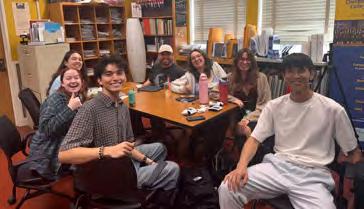
setting the “norms” or chapter culture starts with reinforcing the club’s expectations, professionalism, and enthusiasm for the time spent together. Members will feel welcomed into the ACDA family if, time after time, they are greeted with a fun, dedicated, and intentional community centered around the mission of ACDA. One of these norms, in accordance with “Robert’s Rules,” is having a carved-out time for members to share announcements or personal events with the rest of the club. This time allows members to celebrate each other and strengthen their community bonds. Being sensitive to the interests of members can leave a lasting impression and buy-in to the club’s mission. After each meeting, the chapter can track attendance and share updates on upcoming events through emailed meeting
minutes. Towards the end of the first semester, consider asking members for an honest evaluation of the board and chapter meetings with room for respectful commentary. With this feedback, you may integrate these suggestions for future chapter activities and re-adjust your chapter’s vision as needed.
Once a chapter begins recruiting, it is important to consider ways to keep members engaged and involved in the chapter for years to come. Retention is the key to building a thriving community, and it works as an investment towards the ongoing responsibility of managing a student-run club.
Invest in member interests and involvement. Like managing a classroom,
Conduct student-led performances. A practical way to provide opportunities for students to apply their conducting, teaching, performing, and musicianship skills is to plan student-led performances. In practice, this may take the form of talent shows, caroling, and choral concerts. The CSUF Student Chapter’s end-of-the-year concert is fully programmed, rehearsed, and conducted by the student board. It is a valuable experience for future educators to practice planning rehearsal time and teach music outside of their choral methods classes. Selecting repertoire invites students to consider various
elements of programming, including technical difficulty, languages, orchestration, and textual themes. These performances also introduce participating choir members to new repertoire and provide a safe environment to refine their musicianship skills.
Elect additional student officers as needed. As a chapter grows, it may benefit the student board to elect additional officers, noting that any new positions will likely require a vote to revise the constitution. Popular additions include: Vice President or President-Elect, Fundraising Chair, Social Chair/Event Coordinator, Inter-Club Council Representative, and Diversity & Education Chair. For example, the SJSU Student Chapter votes on a PresidentElect who serves for a year in this position before assuming the role of President the following year. In this working example, the PresidentElect shares the same responsibilities as a typical Vice-President role, therefore negating the need for the latter. The CSUF Student Chapter’s Diversity & Education Chair leads efforts to consider a multicultural lens in music education. The application of this role at CSUF has included small presentations on various historical/cultural holidays or traditions, introductions of diverse choral pieces, sharing of educational resources and events, and reminders of scholarship deadlines.
gain hands-on experience before assuming the role. Prior to voting, it is recommended that all members have the opportunity to ask the nominees questions and engage in group discussion. Members given agency for chapter involvement will likely become more invested in its future and, therefore, inspired to support its legacy.
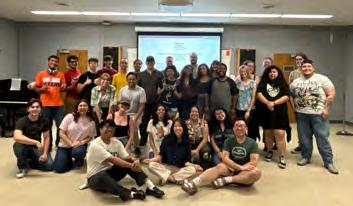
A social event with CSUF’s ACDA student chapter
All things considered, a dedicated board and empowered body of members will lend a strong start to a budding student chapter. We hope that through sharing our experiences, we can help make your process in starting a new chapter or reinvigorating a pre-existing chapter a little easier. All of our additional resources can be found in the QR code below for your convenience. As a gentle reminder, no two chapters will look quite the same, and these tips are not meant to be hard-standing requirements but simply ideas to get you started. We are confident that with your love for choral education, you will find the best approach for your chapter, and we hope that you enjoy the process as we have.
If ever you need a helping hand, please don’t hesitate to reach out to us. From our chapters to yours, we wish you the best!
Pass the baton from one board to the next. A seamless transition will rely on honest communication paired with providing leadership opportunities and strategic preparations by the previous board. Early board elections allow new board members ample time to shadow their predecessors and
Scan the QR code to access lots of resources, includng sample by-laws, BRAND KITS, meeting minutes, and MUCH more!

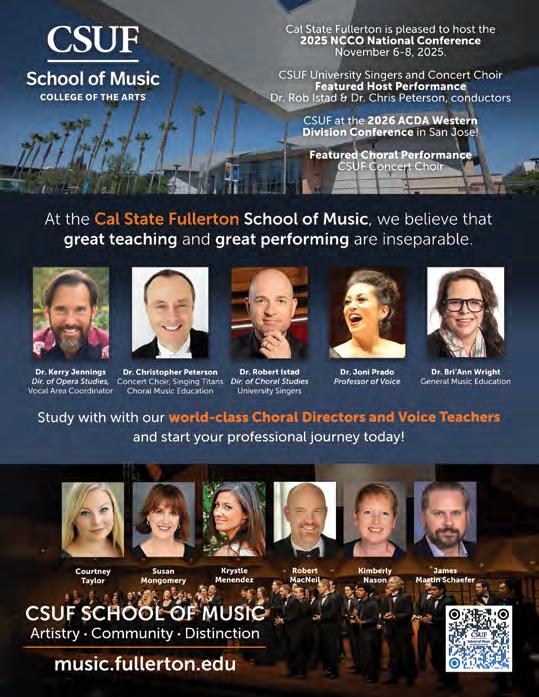
Y’all, we just couldn’t possibly have had more fun at this year’s Summer Conference at ECCO! The 2025 Howard Swan Award was presented posthumously to Dr. Lynn Bielefelt, many of whose students and friends were on hand to honor and remember her. Headliner Andrea Ramsey kept us moving, laughing, and learning. And the Western-themed party reminded us all that choral conducting’s still a pretty good “way to make a living”!
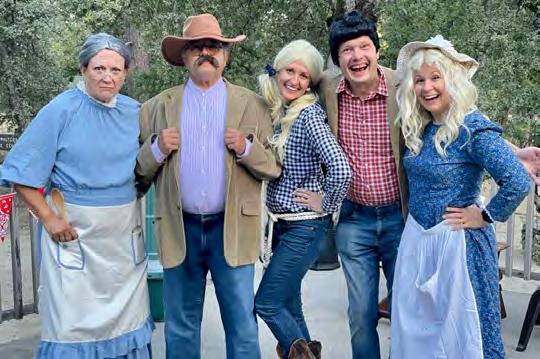
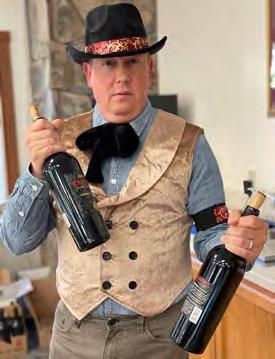
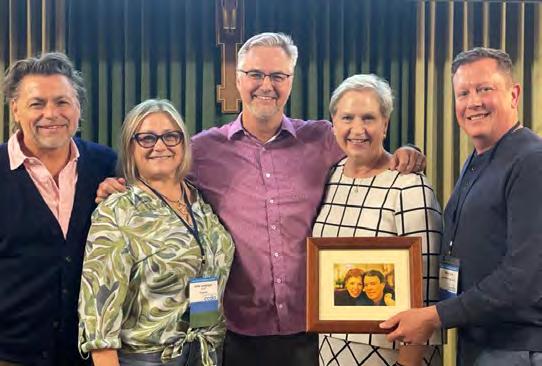
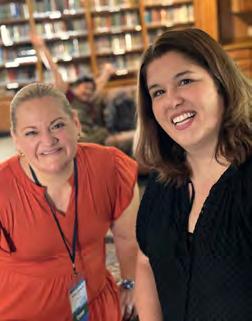
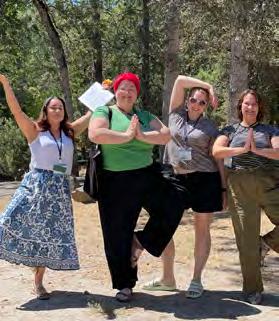
The diversity, equity, inclusion, access and belonging (DEIAB) team is honored to spotlight the remarkable recent achievements of Dr. Iris Levine. Her leadership and impact continue to shape the field, and this fall, she will be recognized as an Honorary Life Member of the National Collegiate Choral Organization. She is also a featured headliner at the NCCO national conference this November at CSU Fullerton. NCCO president Dr. Katherine FitzGibbon said,
“When selecting a headliner for this year’s conference, we wanted someone who truly embodied the theme of transformation someone who uses choral music and connection to inspire change. Dr. Iris Levine was a natural choice. Her career has centered on building community and amplifying underrepresented voices through groundbreaking commissions.”
authentically, and bring your full self—musician, activist, educator—to the table.
KD: How has your background in choral conducting shaped your leadership style and approach to building inclusive, collaborative communities within higher education?
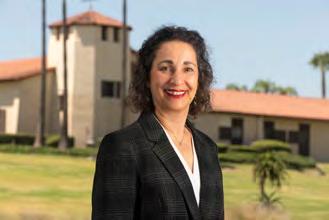
We’re proud to celebrate this milestone with a brief conversation between Dr. Levine and CCDA DEIAB Director, Dr. Kellori Dower.
KD: You’ve made history as the first California choral conductor (to our knowledge) to be named a university president. What does this milestone mean to you and what do you hope it signals to the next generation of artist-leaders, particularly those in marginalized groups?
IL: This milestone is deeply humbling, and frankly, a bit surreal. I never set out to “make history”—I simply followed my love for music, for teaching, and for building community. For me, it represents the validation of the artist-leader: someone who leads with creativity, empathy, integrity, and vision. I hope it signals to emerging leaders—especially those from historically marginalized groups—that your voice, your artistry, and your leadership matter. You don’t have to fit a mold. You can lead boldly and
IL: Conducting a choir teaches you everything you need to know about leadership: how to listen, how to read the room (and the silences), how to bring a hundred different voices together —and how to keep a rehearsal moving without losing your mind. That collaborative spirit has shaped how I lead in higher education. I strive to create spaces where people feel empowered to contribute, and where we all work toward something greater than ourselves.
KD: DEIAB values are central to CCDA and our membership. How have you ensured these values remain embedded as you transitioned from being a full-time choral conductor to the presidency?
IL: DEIAB is not something you set aside when you change roles—it is a mindset, a responsibility, a value, and a lifelong practice. As a choral conductor, I program diverse voices and create space for underrepresented composers and communities. As an administrator, I’ve continued that work by pushing for equitable hiring practices, advocating for systemic change, and holding space for difficult but necessary conversations. It’s about intentionally cultivating environments where diversity is celebrated, equity is pursued, and belonging is felt. That commitment travels with me, wherever I serve, for it is who I am and what I believe.
KD: Why is it important for you to remain an
active choral conductor while serving in administrative roles? What choral conducting or choralrelated activities are you currently involved in?
IL: Conducting feeds my soul—it keeps me connected to the heart of why I do this work. It also keeps me humble. Nothing like standing in front of a choir to remind you that real leadership isn’t about control; it’s about trust, presence, and the occasional eyebrow raise to fix a wrong entrance. I remain active as Artistic Director of VOX Femina Los Angeles, and I take on guest conducting, clinicing, and adjudicating when I can. Staying in the music keeps me real—and frankly, keeps me sane.
KD: What advice would you offer to choral music educators who may be thinking about becoming an administrator?
IL: First, know that your skills as a choral educator are leadership skills. You’re already managing people, visioning long-term goals,
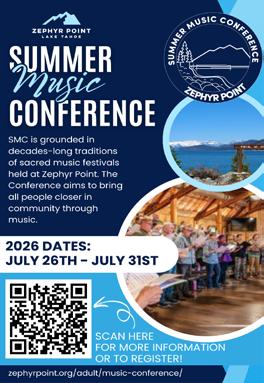
balancing logistics, and building inclusive communities—don’t underestimate how transferable those abilities are. My advice? Say yes to opportunities that scare you a little. Be open to learning a whole new set of acronyms. Stay curious, seek out mentors and don’t lose sight of your artistry—it’s your superpower. You don’t have to choose between being musical and being strategic. With the right mindset (and a strong calendar app), you can do both. If you’re driven by purpose and care about creating spaces where people can thrive, you already have what it takes. Go for it. We need more creative people in administration.
The California Choral Directors Association is committed to diversity, equity, inclusion, access and belonging (DEIAB) in all choral spaces. The DEIAB team is comprised of Dr. Ramon Cardena, Dr. Fabian Rodriguez Castro and led by Dr. Kellori Dower.
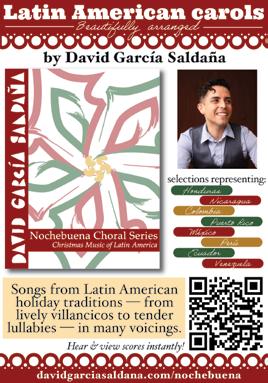
The California Choral Directors Association (CCDA) exists to uplift and empower the choral conductors and singers of California. In a time of heightened social and political instability, we remain steadfast in ensuring that the core tenets of our mission—diversity, equity, inclusion, access, and belonging (DEIAB)—are not just ideals but guiding principles in every aspect of our work. We are committed to fostering choral music experiences that reflect and honor the diversity of our communities.
Guidance and Support: We will actively support all California choral musicians by providing resources and mentorship by our DEIAB team for repertoire selection and programming that promote diverse voices and inclusive storytelling. This includes a complimentary review of programming or repertoire lists, if requested.
Access and Representation: We will make resources available to schools, churches, and community organizations to diversify their choral programs, ensuring that every singer—regardless of background—feels seen, valued, and empowered to sing.
Safe and Brave Spaces: We pledge to create and uphold spaces where conductors and singers can engage in meaningful, courageous conversations that challenge barriers and drive equity forward.
Ongoing Accountability: We will continuously evaluate and refine our programs, processes, and publications through the lens of DEIAB, ensuring that our impact is both intentional and lasting.
We will not waver in our commitment to making choral spaces more equitable, more inclusive, and more transformative for all singers. This work is ongoing, and CCDA stands resolute in ensuring that every voice—on stage and behind the podium—has a place, a purpose, and a future that honors and respects all voices.
This statement was collaboratively crafted by the members of the CCDA Diversity, Equity, Inclusion, Access and Belonging (DEIAB) Team and approved by the Board of Directors of the California Choral Directors Association February 8, 2025
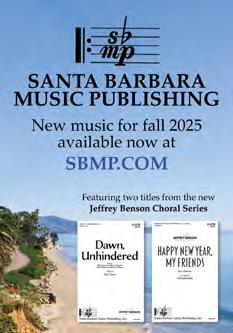




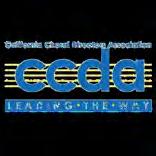


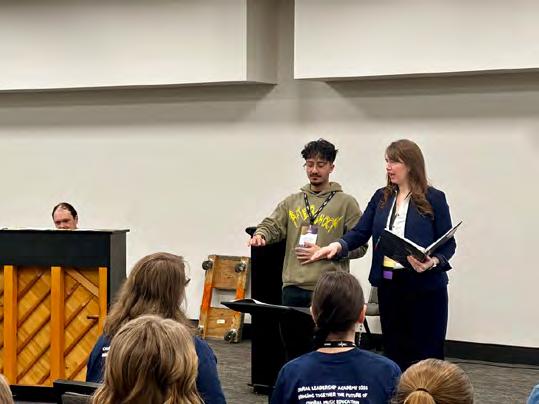

by
After two days of in-person auditions at sites around the state, our High School Regional Honor Choirs will take place ThursdaySaturday, November 6-8, 2025.
Coastal Region Honor Choirs
First Presbyterian Church, Berkeley
Dr. Wei Cheng, SSAA
Dr. Bruce Rogers, SATB
Dr. Lynn Atkins, TTBB
Central Region Honor Choirs
Clovis North High School, Clovis
Dr. Anna Hamre, SSAA
Dr. Matthew Hazzard, SATB
Dr. Arian Khaefi, TTBB
Southern California Region (SCVA) Honor Choirs
University of Redlands, Redlands
Dr. Alyssa Cossey, SSAA
Dr. Carl Earnhart, SATB
Dr. Buddy James, TTBB
Thank you to Kate Huizinga, Marc McGhee, Katie Carbajal, Kristen Walton, and Miranda Ford for chairing these events!
Students who participated in the Regional Honor Choirs who are interested in moving on to the All-State Honor Choirs will be notified of the acceptance lists by November 14th. Registration for All-State will be due by December 3rd.
The All-State Honor Choirs will take place at CASMEC in Sacramento from January 15-17, 2026, with guest directors Dr. Sandra Babb (Junior High SSAA), Dr. Alyssa Cossey (Junior High SATB), Dr. David Morrow (High School TTBB), Dr. Erin Plisco (High School SSAA), and Dr. Sandra Snow (High School SATB). Rehearsals will be held on the campus of Sacramento State University, and Saturday’s
concerts will take place at Sacramento’s historic Memorial Auditorium. We will need chaperones and other volunteers for the All-State Choirs. Please keep your eye out for an email from CCDA soon with details on how to volunteer! Chaperones receive free conference registration, free lodging (double occupancy), and a small stipend.
CASMEC/All-State 2026 will take place in Sacramento from January 15-17, 2026.
Please keep in touch with any questions: honorchoir.allstate.ca@gmail.com. We look forward to another exciting year of CCDA Honor Choirs.
DEGREES OFFERED
Choral Music BM, MM, DMA
Sacred Music MM, DMA
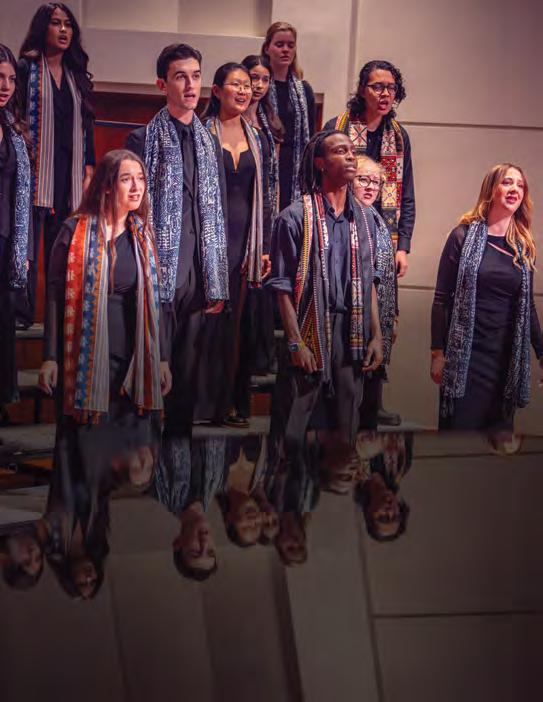
Learn more
APPLICATION DEADLINE DECEMBER 1, 2025
@USCTHORNTON
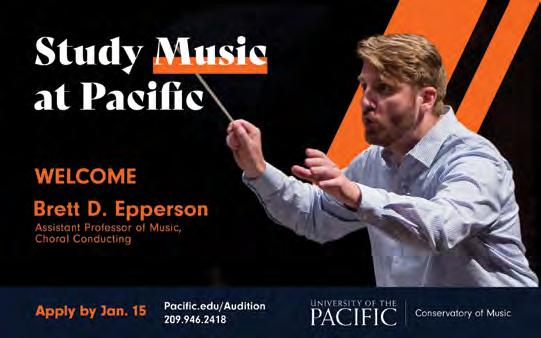
The Cal Poly Choral Program has four choirs: PolyPhonics, University Singers, Cantabile and Chamber Choir. The choirs tour nationally and internationally. There are opportunities in classical, jazz, opera and more!
Scott Glysson / sglysson@calpoly.edu Director of Choral Activities and Vocal Studies
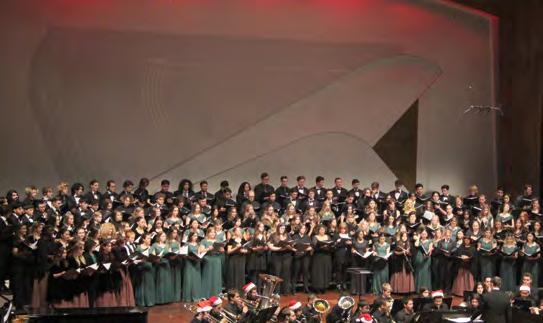
facebook.com/cpmusic
MUSIC MAJOR FOCUS AREAS
• Music Education
• Composition
• Music History
• Ethnomusicology
• Music Technology
• Jazz
• Performance
CAL POLY
Cal Poly is located in San Luis Obispo, on California’s beautiful Central Coast. Cal Poly is accredited by the National Association of Music (NASM).
facebook.com/cpmusic
I’m passionate about CCDA, and I am excited to be taking on the role of Director of Development! One of the best things about this job has been digging into all of the good work we do to support California’s vibrant choral communities These scholarships and grants, along with our George Heussenstamm Choral Composition Contest and upcoming Huszti Conducting Prize will have a lasting impact on our profession for decades to come. CCDA is truly leading the way!
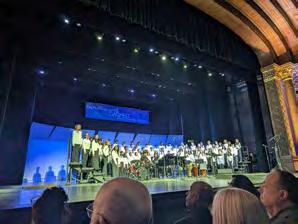


I hope that you will consider becoming a CCDA sustaining donor in order for us to continue and expand this important work Even a small contribution of $5-$10 a month can make a lasting impact on our ability to move forward If you prefer to make a single donation you can earmark your funds for the program for which you feel the most passion 2024-2025 HONOR CHOIR
1.

GENEVIEVE TEP CCDA DEVELOPMENT DIRECTOR
HONOR CHOIRS $4,800 2 ALL STATE HONOR CHOIRS $8,600 TOTAL $13,400!
VISION FOR THE FUTURE
SUPPORTING CCDA STUDENT ME MBERS & WORKING PROFESSIONALS
CHORAL EQUITY SCHOLARSHIP CREATIVITY GRANT
DR CHARLES C HIRT SCHOLARSHIP
DR. WILLIAM HALL ECCO SCHOLARSHIP
SUMMER CONFERENCE SCHOLARSHIP
TOTAL $8,660! APPLICATIONS AVAILABLE TO CCDA ME MBERS IN THE SPRING!

CCDA DISASTER RELIEF FUND SUPPORTING CCDA MEMBERS AFFECTED BY WILDFIRES
TOTAL $2,345!
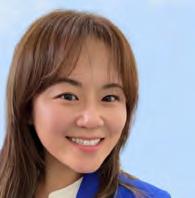
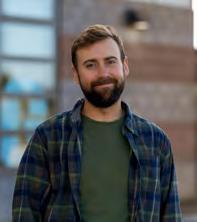
Brandon Ellsworth 2025 Creativity Grant recipient
“Ihad the distinct privilege of participating in the 2025 Montreal Summer Choral Academy, held in June at McGill University, as a member of the Conducting Track under the guidance of Dr. Jean-Sébastien Vallée. With the generous support of the California Choral Directors Association, I joined a cohort of emerging conductors from around the world for an intensive and immersive week of study, rehearsal, collaboration, and performance. I am profoundly grateful to CCDA for supporting my participation in this experience. The Montreal Summer Choral Academy has enriched my conducting practice, broadened my artistic perspective, and reinforced my dedication to fostering community through choral music. Thank you again for your generous support and for investing in the next generation of choral leaders.”
“This summer, thanks to your support, we launched SingAble, an accessible community choir in San Jose designed to bring together singers with and without disabilities in joyful, multigenerational, inclusive music-making. Our goal was simple: to build a space where everyone—regardless of age, ability, or experience—could sing, connect, and be heard. Over the six weeks of rehearsals, we watched strangers become collaborators and music take shape for people who have been historically shut out of musical spaces. This was truly a magical program that serves not only individuals with disabilities but also community members who are advocates for a more inclusive world. It’s been the privilege of my lifetime to help make that home a little bit bigger and a little bit more accessible and inclusive. Thank you from the bottom of my heart for making this dream come true—not just for me but on behalf of all of our singers.”
This list includes donations made between JulY 15, 2024, and AUGUST 15, 2025. Donations made after that time will be acknowledged in the next Cantate and may be found on our website. Thank you for your support!
President’s Circle
Diamond ($1000 and higher)
Resounding Achord
Dr. Arlie Langager*
Susie Martone
David Masone and William Hall
Legacy Giving, in honor of Dr. Gene Peterson, Dr. Jonathan Talberg, and Dr. Joseph Modica
Ken Rawdon
Lori Marie Rios and Bryan D. Walker*, in honor of Shirley Nute, Don Brinegar, and Bruce Mayhall-Rastrelli
Trevor Strohman
Burt and Polly Vasché*
President’s Circle
Platinum ($500-$999)
ACFEA Tour Consultants
Dr. Daniel Afonso Jr*, in honor of Bill Hatcher
Mike and Julie Dana*, in celebration of ECCO conference
Lou and Mary De La Rosa*, in memory of Jim Heiner
Angelina Fitzhugh
Keith Hancock
Duand and Linda Lovaas*
MaryClare Martin*, in honor of Lena and Art Babin and Signe Boyer
Bob Rogers Travel, Inc. National Concerts
President’s Circle Gold ($300-$499)
Florence Agcawili
Oscar Luna, II
Marc McGhee
Kristina and Ryan Nakagawa*, in memory of Lois Carah and Joe Huszti
Beth Nitzan and Rob Blenk
June Ou
Susanna Peeples*, in memory of Germán Aguilar
Cliff and Cindy Samson, in celebration of Joe and Melinda Huszti
Magen Solomon, in memory of Joe Huszti
Dr. Jonathan Talberg*, in honor of Dr. William Hall
President’s Circle Silver ($100-$299)
Lorna and Haroutune Bedelian, in memory of Joseph and Melinda Huszti
Felicia Bessent
Patrick Burzlaff
Lauren Diez
Karen Fulmer
Jennifer Gaderlund
Brian Gorelick
Marty Haynes
Dr. Ron Kean*, in memory of Dr. Lynn Bielefelt
Chiara Njoo Ko, in memory of Joseph and Melinda Huszti
Ludus
Richard S. March, in honor of Dr. Don Kendrick
Richard Martone
Hugh McDevitt
Emily Moore
Christina O’Guinn
Lynn and Steve Overcashier
Jeff Peckham
Molly Peters, in honor of Lori Marie Rios
Zanaida Robles
Genevieve Tep*
Randeep Toor
Sponsor ($50-$99)
Ruth Charloff
Allison Crose
Dr. Cari Earnhart
Brett Epperson
Jason Gallardo
James Jirak
Suzanne Martone
Lisa McCormick
Willi Mickelson
Sheela Raju
Sandy Rosales
Laryssa Sadoway
Karyn Silva and Dan Kildahl
Susan Swerdlow
Supporter (up to $50)
Stephanie Alvarez
Katie Carbajal
Loreen Dunbar
Shelley Durbin, in memory of Charles Irvin
Joy Gage
Mrs. Maggie Goodrich Gutierrez
Mary Hamilton
Scot Hanna-Weir
Beth Holtan
Albert Mabeza
Linda Manuilow
Hillary Ngo
Michael Ortiz
Issac Pereschica
Andreas Preponis
Noah Sutherland
Dr. Ángel M. Vázquez-Ramos and Jody R. Vázquez*
Ryan Yoder
William A. Zinn*
* Founder’s Circle
Andreas Preponis and the vocal jazz ensemble BayBop hosted the Bay Area Vocal Jazz Academy at Las Positas College. Over 100 students and teachers flocked to Livermore for this one-day immersive experience with clinicians Michelle Hawkins, Christine Guter, and Matt Falker.
Dr. Cari Earnhart and the Fresno State Choirs successfully held their annual Sound Off! Festival for tenors and basses. The festival brought together over 500 middle and high school tenors and basses throughout the Central Valley. The clinician for the event was Robert T. Gibson.
Grand Terrace High School in San Bernardino County will be looking for a choir director as their current teacher transitions to a new assignment.
Dr. Brett D. Epperson is the new assistant professor of choral conducting at University of the Pacific, where he will direct the Pacific Singers and the University Chorus and teach conducting. Epperson comes to UOP from Hastings College in Nebraska, where he has served as assistant professor of music and director of choral activities since 2022.
Send us news to share about hirings, retirements, collaborations, commissions, premieres, awards, or projects!
Downey High School EPIC Jazz Choir (Corey Olariu).
California State University, Northridge welcomes Dr. Stephanie Reyes as the new Director of Choral Studies. A GRAMMY-nominated music educator, active clinician, conductor, and vocalist, Dr. Reyes brings a dynamic background in collegiate and secondary choral education, interdisciplinary collaboration, and advocacy for diverse voices in music. She joins CSUN after serving as Visiting Director of Choral Studies at New Mexico State University from 2023 to 2025 and holds a Doctor of Musical Arts in Choral Conducting from Texas Tech University. Dr. Reyes is excited to begin forming new relationships within the vibrant California music education community and looks forward to building on CSUN’s legacy of excellence in choral music!
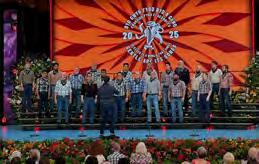
Dana Alexander retired from Montgomery High School in Santa Rosa after 26 years of service. Andrew Hathaway, who recently completed the Masters program at San José State University, will be taking on the position and continuing the wonderful legacy that Dana has created.
A big congratulations to the following California choral directors and their ensembles for being selected to perform at the Western Region ACDA in San Jose in March. Our organization will have strong representation from ensembles across the state. We can’t wait to hear your choirs! Cantabella Children’s Chorus (Clement Cano), Ragazzi Boys Chorus (Travis Rogers), Choral Audacity (Darita Seth), Castro Valley High School (Laryssa Sadoway), Foothill High School (Chelsea Dehn), Los Gatos High School Treble Choir (Maricel Riley), Westminster Chorus (Dan Wessler), California State University, Fullerton Concert Choir (Christopher Peterson), and
Jordan Pulido was recently hired as the Choral Director at Roosevelt School of The Arts located in Fresno.
In July, two California choruses took the stage for the Choir of the World competition at the International Musical Eisteddfod in Llangollen, Wales: the CSULB Bob Cole Chamber Choir, directed by Jonathan Talberg, and Men in Blaque (pictured), directed by Andrew Ball and Michael Ushino
Send your news items and photos to MARC McGHEE at mmcghee@luhsd.k12.ca.us!
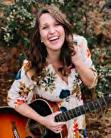
Paige burzlaff teaches music to toDDlers
through Junior high schoolers in baKersfielD, ca she is the owner
anD Director of the chilDren’s voice stuDio, a multi-teacher, KoDálY-insPireD stuDio that ProviDes classes anD Performance oPPortunities for chilDren. Paige holDs a ba in music from luther college anD is KoDálY certifieD through the csub KoDálY institute, where she teaches level 1 PeDagogY
anD folK literature
she is a Presenter at local conferences anD sPecializes in helPing
chilDren DeveloP inDePenDent singing sKills
It’s the first ten minutes of the first day of Junior High choir. As we’re nearing the end of warm-ups, a hand shoots up. “Are we going to play a game?”
Of course we are! Today we are learning “Tue, Tue,” a Ghanaian folk song and clapping game. I demonstrate the clapping motions while singing the song for them. The melody is simple and easy to learn. Before long we are all playing, singing, and laughing. When we get back to our seats, the sheet music for “Tue, Tue” is in their folder, and they have a head start to wherever we are going next, whether that be singing the melody on solfege, reading the rhythm, or part-work.
In future rehearsals we will broaden our understanding of the song and the culture that it represents. Perhaps we will listen to a field recording of the song and identify variations, or watch a video of Ghanaians singing and playing the clapping game, or add traditional percussion instruments.
If Kodály training has taught me anything, it is the power of Folk Music in engaging and training young singers. There’s nothing my Junior Highers love more than to get up, get moving, and play a singing game while getting many repetitions of our new song into their bodies and voices.
Folk music is a rich resource for the Junior High choral rehearsal and a gold mine for skill-building, cultural understanding, and fostering a love for singing. Folk songs feature straighforward melodic lines, often pentatonic and limited in range. The simple and repetitive rhythmic patterns in many folk songs aid in developing rhythmic precision and literacy.
Folk music is historically designed for group participation, encouraging active engagement and a sense of community. Many folk songs include games, movements, or calland-response elements that can be incorporated into the rehearsal. Folk songs often tell stories, reflect historical events, or highlight daily life, providing a window into different cultures and traditions, and allowing students to connect on an emotional level. The ability to teach songs using motions, games, and storytelling can be
highly motivating for young singers. Here are five folk songs for engagement and skill-building that my Junior Highers loved:
Arr. ruth Morris GrAy
Tue, Tue (Ghana)
Alfred Music Publishing
The layered ostinatos and repeated sections allow the piece to come together in no time. Consider adding traditional Ghanaian percussion instruments or demonstrating the clapping game at your performance!
Arr. MAry Goetze
The Little Birch Tree (Russia) Boosey & Hawkes
This arrangement with an optional flute part is an excellent choice for building beautiful unison tone. Students will enjoy exploring the balalaika (bring one in if you can)! I love this piece for introducing dotted rhythms. Consider singing a verse in Russian for an extra challenge.
Arr. DonAlD Moore
Ma Bella Bimba (Italy)
Alfred Music Publishing
Try introducing this song as a tongue twister! Add balloons and movement to emphasize the buoyancy of the catchy melody, with options to sing it in Italian, English, or both.
Arr. PhiliP silvey
Nine Hundred Miles (USA)
Santa Barbara Music Publishing
The story of a mysterious train journey, which is reflected in the vocal harmonies and gorgeous piano accompaniment, will capture the imagination of your students.
Arr. JuDith herrinGton AnD sArA Glick
Fum, Fum, Fum (Spain)
Pavane Publishing
This traditional Christmas carol is percussive and fun to sing, imitating the strums of the Spanish guitar. The harmonies are easily accessible and students will love the chance to play a percussion instrument. Baritones especially seem to love this one!
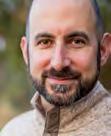
anDreas PrePonis is the Director of choral
anD vocal stuDies at las Positas college in livermore born anD raiseD in germanY, he holDs bachelor’s anD master’s Degree in music eDucation from the staatliche hochschule für musiK trossingen (the hometown of hohner harmonicas) as well as a master ’ s Degree in choral conDucting from csula he currentlY serves as the vocal Jazz liaison on the boarDs of ccDa anD ca J.
Ioften hear educators say they would like to start a vocal jazz ensemble but don’t know exactly how. The logistics of running a VJ group can be daunting. My recommendation? Don’t wait for the perfect gear or a good rhythm section. Instead, start introducing vocal jazz repertoire in your regular choirs and get the students started on singing crunchy harmonies and syncopated rhythms. You can figure out the rest as you go.
These very accessible arrangements sound good no matter if sung by small groups on individual mics or by large choirs unamplified and with piano only.
Peter elDriDGe
Wish You with Me SAB with piano; Level 2 / SSATB with piano; Level 3 www.kerrymarsh.com
A great entryway into vocal jazz is the cross section where jazz meets pop meets contemporary choral music. This pensive composition is a quick learn, and the SAB chart has just enough colorful crunch to stretch the ears of beginning choristers. It also contains a brief ad lib section that exposes students to modal improvisation. Can they catch the #4 when changing from F major to F Lydian and back? For more crunch, check out the SSATB version.
Arr. roGer eMerson
Don’t Get Around Much Anymore 2-part or 3-part with rhythm section; Level 2 www.halleonard.com
This arrangement from Roger’s Discovery Jazz Series is easy to learn and fun to sing. The students practice syncopated rhythms in swing feel, chromatic melody lines, and tuning the tritone in dominant seven chords.
Arr. MAtt FAlker
Make Someone Happy SAB a cappella; Level 2 www.anchormusic.com
A piece I return to often, both with VJ ensembles and Chamber Choirs. Tried and true, this rubato ballad is masterfully arranged, using intricate
harmonies in an SAB setting. It is listed as level 2 but is more of a level 3 chart, with chromaticism, surprising melodic leaps, and pretty much any combination of intervals there is; not easy to tune, but fun to sing. The beautiful lyric provides lots of opportunities to address phrasing for text painting.
Arr. kirby shAw
Sway (Quien Sera?)
SATB, SAB or SSA with rhythm section, Level 2.5
www.halleonard.com
Sometimes you have to return to the OGs. Always playful (sometimes corny), Kirby has understood the assignment: write accessible arrangements and fun-to-sing harmonies that audiences love. Students learn harmony in 4-part writing with the occasional drop-2 voicing. It can be sung in English or Spanish, and the “optional dance break” (did I mention corny?) can be easily turned into a scat solo.
Arr. GreG JAsPerse Fields of Gold SATB a cappella, Level 4 www.halleonard.com
Greg Jasperse is the epitome of an arranger/composer who straddles the line between jazz, pop, gospel, and contemporary choral music. His catalog has music of all levels of ensembles, traditional and vocal jazz alike, be it his arrangements of My Romance or the Beatles, his original compositions like the Voice Dance series, or his 8-part version of Amazing Grace. This setting of Sting’s “Fields of Gold” includes rich harmonies, great voice leading, scintillating chromaticisms, two key changes, and beautiful text painting.
For more repertoire suggestions and resources, check out clinics offered at CASMEC, ECCO, local conferences, festivals or through vocaljazzacademy. com. If you need help with gear or would like a vocal jazz educator to work with your students, reach out. I am happy to connect you with someone in your area.

Jesse Diaz serves as Director of choirs at reDlanDs high school, where he is in his eleventh Year
leaDing a vibrant anD nationallY recognizeD choral Program. before moving to california, he sPent ten Years teaching vocal music in the miDwest, builDing Programs grounDeD in artistrY, communit Y, anD stuDent growth. he holDs a bachelor of music in music
eDucation from milliKin universit Y, a master of music in music eDucation from ball state universit Y, anD a master of science in curriculum anD instruction from governors state universit Y
For this list (a Top Five and a bonus!), we focused on repertoire for secondary, collegiate, and community SSAA choirs. These selections have become favorites not only for us as conductors, but also for the singers who learn and perform them.
Advanced Middle School, NonAuditioned High School, or Community Treble Ensemble
uno nAissoo
Metsa Telegramm (The Woodpecker’s Warning)
SSA and piano, with woodblock or rhythm sticks
Hal Leonard
This lively piece, available in both Estonian and English, begins in unison with the voices echoing the woodpecker’s call—“Tok, tok, tok”— reinforced by the woodblock. In the middle section, sopranos and altos toss the melody back and forth before returning to the opening theme, fading into a final whisper. A charming call to preserve the beauty of the forest!
Arr. ruth elAine schrAM
The Turtle Dove
SSA and piano
BriLee Music Publishing
Schram’s setting of this traditional English folk song is tender and expressive, featuring flowing vocal lines, gentle dissonances, and a poignant sense of longing. The simple harmonic structure allows for growth in part independence, supported by a rich and expressive piano accompaniment. A beautiful opportunity to develop blend, phrasing, and sensitivity.
Auditioned/Advanced High School, University, or Community Treble Ensemble
MArie-clAire sAinDon
Terre-Neuve
SSAA a cappella and body percussion
Cypress Choral Music
This vivid and percussive piece evokes the rugged landscape of Newfoundland, with a dramatic chordal opening
giving way to rhythmic interplay and body percussion. A quieter section follows before building to a joyful and energetic conclusion. According to the composer, “Terre-Neuve is a love letter to the powerful geology that is the island of Newfoundland and its ancient mysteries.”
DAn Forrest
Come to Me
SSAA and piano (optional cello)
Beckenhorst Press
Forrest’s SSAA arrangement offers singers a chance to explore expressive nuance, dynamic contrast, and unified vocal blend. A featured soprano solo provides a valuable opportunity to work on balance between soloist and ensemble. The piece is accessible yet artistically rich.
ron JeFFers
This We Know SSA(A) a cappella earthsongs
Set in a simple homophonic style, this moving piece supports Chief Seattle’s statement on the interdependence of all life. With some tricky harmonic shifts, the piece builds to a powerful climax on the words “all things are connected,” then recedes before building again to a final, quiet A major chord that leaves a lasting impact.
DAniel brinsMeAD
Sea Fever (from Five Sea Songs) SSA and piano
Walton Music
With driving rhythms, colorful harmonies, and vivid text painting, this piece challenges singers to convey both energy and control. It develops rhythmic precision, vocal agility, and storytelling through music. The natural momentum mirrors the pull of the sea, making it a thrilling opener or closer.
These treble choir recommendations represent a collaboration between Cricket Handler, Co-Artistic Director of Canzona Women’s Ensemble in San Luis Obispo, and Jesse Diaz
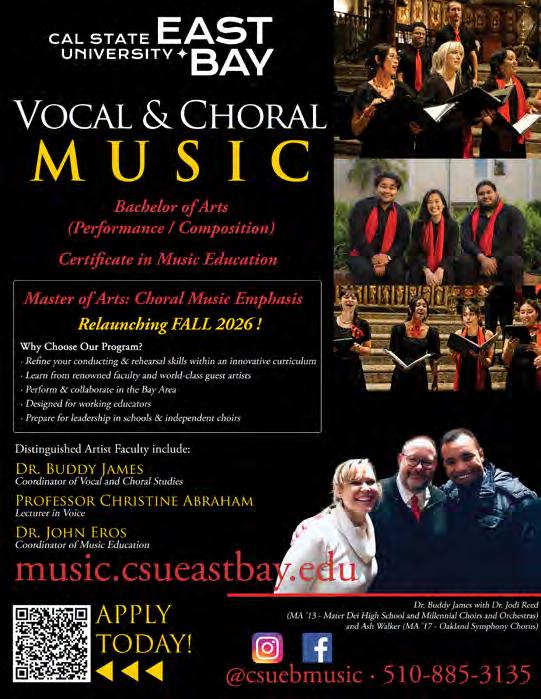
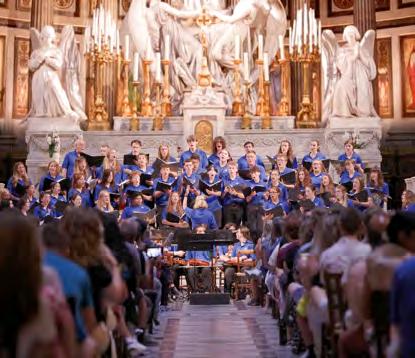



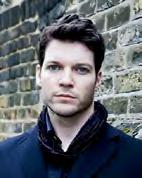

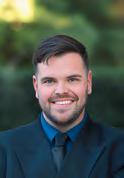

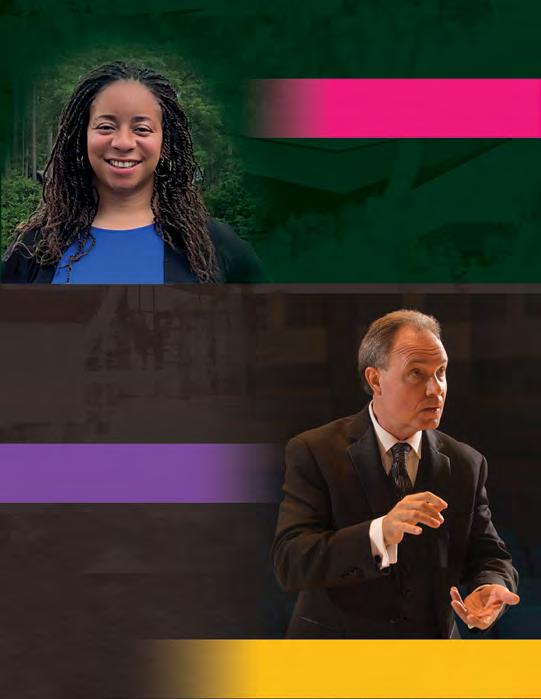
Prof. Bruce Rogers brings many years of experience as the former Director of the Mt. San Antonio College Chamber Singers—one of the most exceptional and award-winning collegiate ensembles in the country. Prior to his appointment at Mt. SAC, he taught at Upland High School where his choirs were invited to both regional and National conventions of the ACDA.
Dr. Gibson will be teaching classes within the music education curriculum and Prof. Rogers will be teaching choral conducting and repertoire.
For more information about the choral program at CSULB, please contact Dr. Jonathan Talberg at: jonathan.talberg@csulb.edu
Bob Cole Conservatory of Music is thrilled to welcome Dr. Michelle Gibson and Prof. Bruce Rogers to our faculty in 2025-2026.
Dr. Gibson taught public elementary and middle school choir, band, general music, and musical theater for nine years in the metropolitan Atlanta area prior to pursuing doctoral studies at the University of Florida.
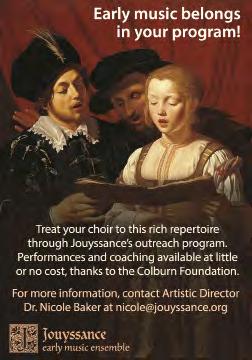

proud publishers of the



Dr. Shawna Stewart is the Director of Choral Studies at Biola University in La Mirada, CA. Dr. Stewart is a graduate of the Eastman School of Music and the University of Southern California, having studied under the tutelage of Dr. William Dehning.

To see our complete choral catalog, visit www.PavanePublishing.com.
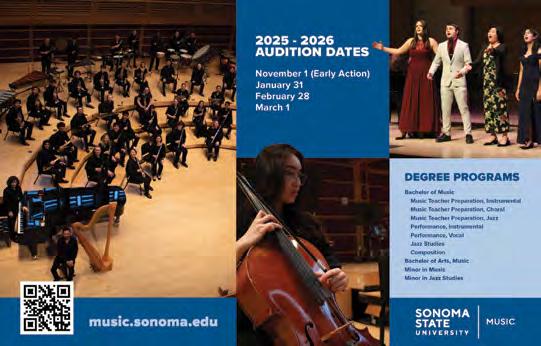






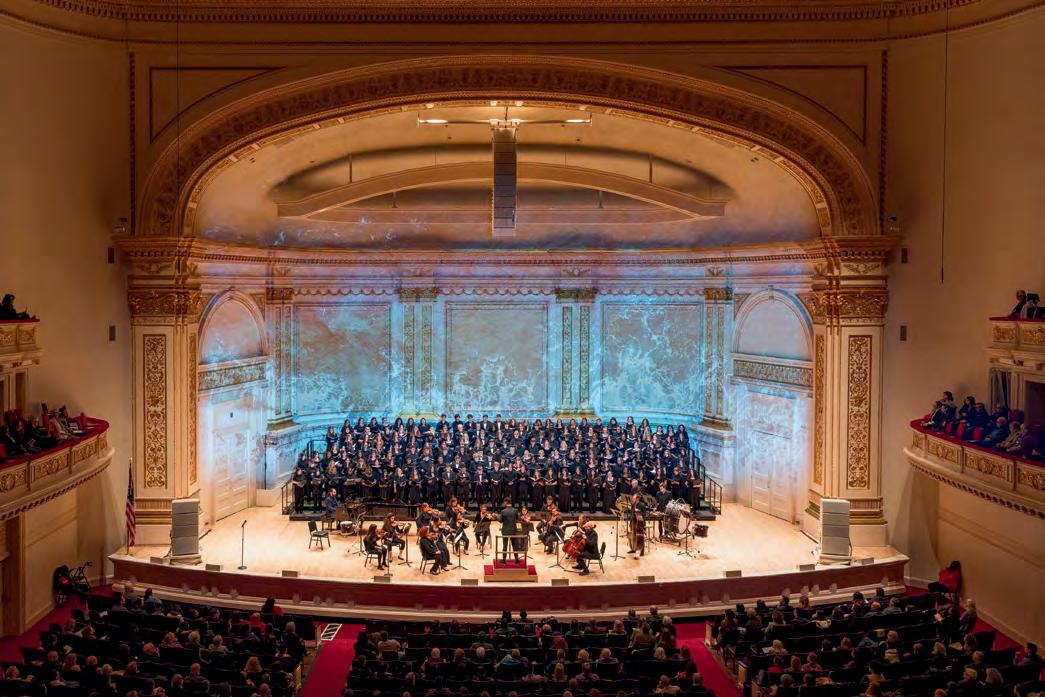










































President
Kristina Nakagawa kristina.m.nakagawa@ gmail.com
Past President
Arlie Langager alangager@miracosta edu
President-Elect
Molly Peters mepeters79@gmail.com
Children’s & Community
Youth
Karyn Silva ksilva@peninsulagirlschorus.org
Choral Composition
Matt Brown matt@ mattbrowncomposer.com
Community Choirs
Yewon Lee yewonlee98@gmail.com
Community College
Lou De La Rosa l delarosa wvc@gmail com
Music in Worship
Jason Gallardo jgallardo@scu edu
SSAA Choirs
Jesse Diaz jesse diaz@redlands k12.ca us
Vocal Jazz
Andreas Preponis apreponis@ laspositascollege.edu
Cantate magazine editor
Eliza Rubenstein cantate.editor@gmail.com
Social media
Ryan Yoder r.yoder@bonita.k12.ca.us
Webmaster
Kelly Walker kellyeshoff@gmail com
Web editor
John Nguyen nguyenjoe964@gmail.com
E-mail coordinator
Emily Moore emoore@musd org
Liaison to past leadership
Lori Marie Rios lmrdiva1@gmail.com
Secretary/Executive Administrator
Kathleen Preston 921 N. Harbor Blvd., #412, La Habra, CA 90631-3103 exec admin@calcda.org
Treasurer
Beth Nitzan beth.nitzan@gmail.com
Development
Genevieve Tep gtep@seq.org
Membership
Marc McGhee mmcghee@luhsd.k12.ca.us
Director at Large
William Zinn wzinn6023@gmail.com
DEIAB
Kellori Dower drkellori@gmail.com
K-12 Student Programs
Patrick Burzlaff patrick burzlaff @kernhigh org
Community and Worship
Kieun Steve Kim kieunstevekim@gmail com
Education and Student Outreach
Cari Earnhart cearnhart@csufresno edu
Communications
Ryan Yoder r.yoder@bonita.k12.ca.us
CCDA at CASMEC
Jennifer Heder jenniferheder@gmail com
CLA/CASMEC
Hillary Ngo choralleadershipacademy @gmail com
All-State Honor Choirs
Jenni Gaderlund
Susanna Peeples honorchoir.allstate.ca @gmail.com
Central Region honor choir
Katie Carbajal (2025) Marc McGhee (2024) honorchoir.central.ca @gmail.com
Coastal Region honor choir
Kate Huizinga coastalhonorchoirchair @gmail com
ECCO Summer Conference
Jeffe Huls jeffe.huls@gmail.com
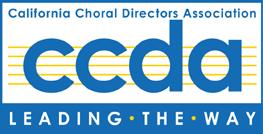







corie.brown@sjsu.edu
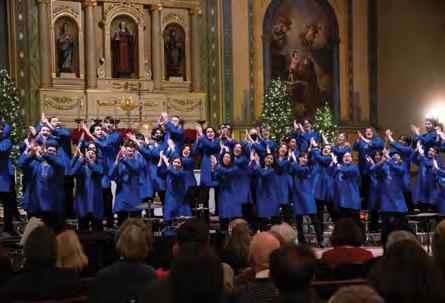
jeffrey.benson@sjsu.edu











